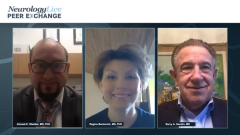
Use of High-Efficacy Therapy in MS in Clinical Practice
Regina Berkovich, MD, PhD, shares her approach to selecting high-efficacy therapies in clinical practice for patients with multiple sclerosis.
Episodes in this series

Ahmed Z. Obeidat, MD, PhD: Dr Berkovich, reading about your journey with treating MS [multiple sclerosis] and your history, I found a personal connection where you’ve seen people who are dear to your heart who have MS. At the time, there were no treatments, and you saw the quick deterioration of neurological function that no one could do anything about. Now it’s a different time. I’d like to also hear your input on the use of high-efficacy therapy in MS in relation to your own practice, but also philosophically in multiple sclerosis overall, tying in your personal experience.
Regina Berkovich, MD, PhD: I appreciate that you refer to my experience as not only as a physician but as a child as well. Indeed, it was a very close family member who deteriorated from MS before my very eyes. There were no disease-identifying therapies available then, and the therapies for acute MS weren’t offered without hesitancy. The delay in decision-making was astonishing and devastating for the patient and family members. There are too many examples like this because I grew up in Poland and Russia. As you know, the prevalence of MS there is very high. You inevitably come across friends and family members who have been diagnosed with it. This in addition to my practical experience shows the importance of using high-efficacy therapy early.
It’s important for us to remember that we have several agents that would be classified as high-efficacy therapy. It’s not just 1. It’s important to remember that we may have some subtle geographical differences in what we define as high-efficacy therapy. For example, European countries say that S1PR modulators should be seen as high efficacy. In certain situations, as Dr Barry Hendin said, that’s because when they’re compared with other active agents, they inevitably show superiority to those agents. They were compared with interferons and teriflunomide, showing superiority. Those are important factors.
For some patients, it can be sufficient, but for some others, it may not be. In my practice, if I see a person with more of the poor prognostic indicators, then my intention, of course, would be to put them on higher-efficacy treatment. If we step up, we end up facing more or less 3 classes of medications. If we go chronologically, 1 would be a VCAM inhibitor, or barrier-trafficking prevention with natalizumab. The second would be the medications that promote depletion following repopulation of the cells. Those medications would be cladribine and alemtuzumab. Finally, we have the B-cell depletion therapies, the agents that deplete the antibody-producing lymphocytes, which convert to plasma cells that immediately evolve in the production of the antibodies.
We have the choice of all these medications. It’s perfectly fine to go with any of these mentioned classes and expect full control of the disease. In fact, we’ll have a much better chance compared with what we can see using the conventional first-line therapies, such as interferons or glatiramer acetate.
Ahmed Z. Obeidat, MD, PhD: This is very helpful.
Transcript Edited for Clarity
Newsletter
Keep your finger on the pulse of neurology—subscribe to NeurologyLive for expert interviews, new data, and breakthrough treatment updates.
































